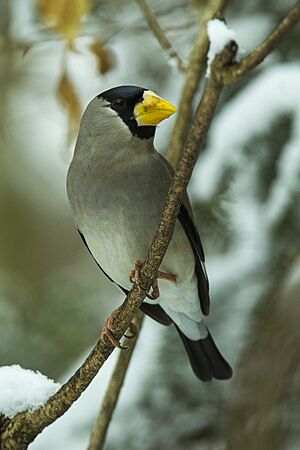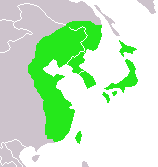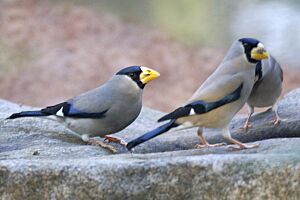Japanese grosbeak facts for kids
Quick facts for kids Japanese grosbeak |
|
|---|---|
 |
|
| A Japanese grosbeak in Honshu, Japan | |
| Conservation status | |
| Scientific classification | |
 |
|
| Synonyms | |
|
The Japanese grosbeak (Eophona personata) is a cool type of finch bird. It lives in East Asia. People sometimes call it the Japanese or masked hawfinch. This is because it looks a bit like the well-known Eurasian hawfinch.
Contents
What Does a Japanese Grosbeak Look Like?
The Japanese grosbeak is a large finch. It can weigh about 80 g (2.8 oz). This bird is usually between 18 to 23 cm (7.1 to 9.1 in) long. Its most special feature is its big, pointy, bright yellow bill.
Adult grosbeaks have a large black area on their head. This black part goes from the back of their neck to their chin. It also covers their ears and goes down to their neck. The sides of their neck are a light, whitish-grey color. Their belly is a duller grey. The back of the bird is greyish-brown. Its sides have a warm, reddish-brown color.
The wings and tail of the Japanese grosbeak are black. But they have a white patch on the inside of their wings. There is also a white band in the middle of their main flight feathers. You can see this white band when the bird flies. Young Japanese grosbeaks are a duller grey all over. They do not have the black markings on their head.
Different Types of Japanese Grosbeaks
There are slightly different types, called subspecies. One subspecies, E. p. magnostris, is a bit bigger. It is also usually lighter in color. This type has a smaller white patch on its wing feathers.
What Sounds Do They Make?
Japanese grosbeaks make different sounds. When they fly, they often make a short, sharp tak tak sound. Their song is a series of four flute-like whistles.
Where Do Japanese Grosbeaks Live and What Do They Eat?
Some Japanese grosbeaks are completely migratory. This means they travel long distances. They breed, or have their babies, around the Amur River, Ural Mountains, and Manchuria. Then, they fly south for winter. They often go to Hebei and Beijing in China. Sometimes, they even go as far south as North Korea.
The other main type of Japanese grosbeak lives in Japan. You can find them from Hokkaido to Kyushu. These birds do not migrate as much. But they do move around a lot in winter. They are mostly looking for food during this time.
Japanese grosbeaks are quite common in some places. They can even be found in large numbers where there is plenty of food. They like to live in forests with deciduous trees, which lose their leaves. They also live in mixed forests. These birds are more often found in valleys than on hillsides. You might also see them in woods with oak and birch trees. They also like parks and gardens with many trees. In winter, they might live near farms.
These birds usually live in pairs or small groups. They can be quite shy. They often stay hidden in the leaves high up in the trees. But you can often tell where they are by listening to their calls.
What Do They Eat?
Japanese grosbeaks mostly eat different kinds of seeds and insects. In winter, they mainly eat cedar nuts. They also eat birch seeds and berries. During the summer, they eat mostly insects. They often eat caterpillars and beetles.




